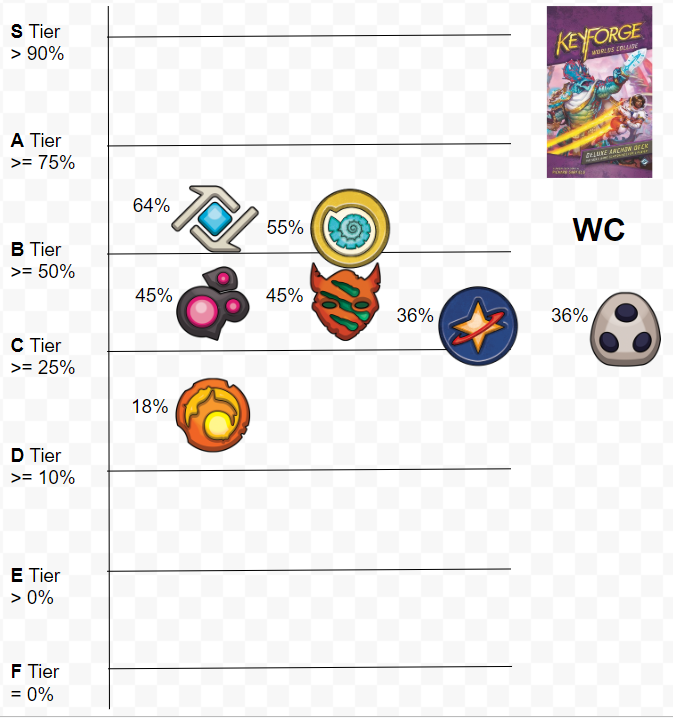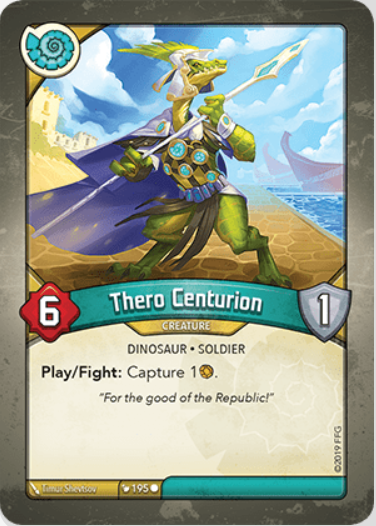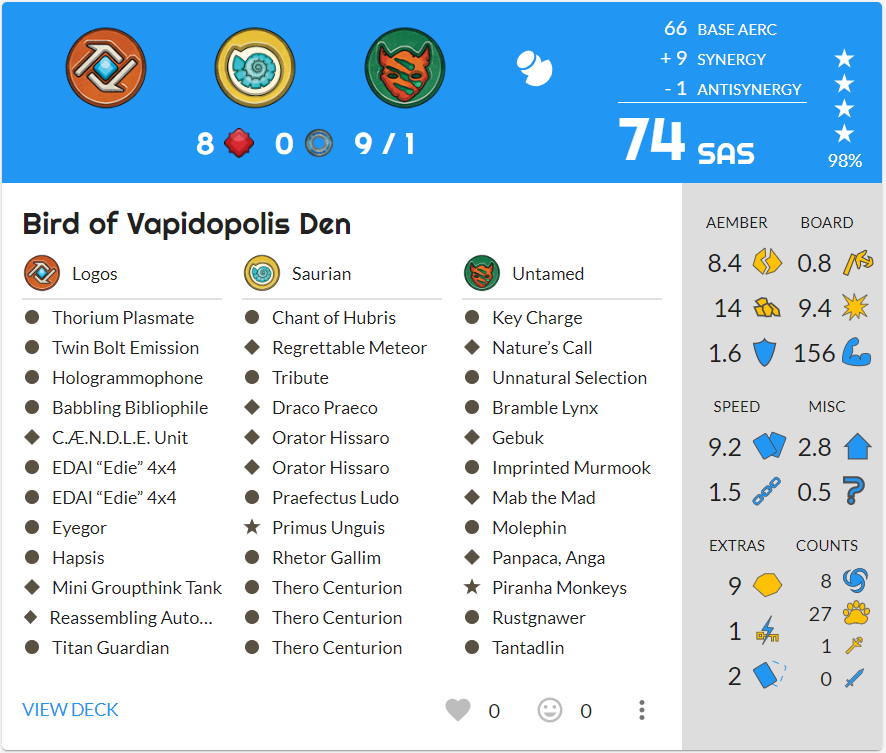
February 2020 Meta Report –
Fort Worth, TX Sealed Vault Tour
Have you ever wondered which decks are good enough to compete at the highest level? My goal is to address this for you.
This analysis is all based on the 11 decks that made the top cut from the sealed format at the Fort Worth, TX Vault Tour on February 6-9, 2020.
This vault tour was the Sealed format, meaning only World Collide (WC) decks were used. Therefore, we cannot determine how powerful each set is in the current meta based on this vault tour. Instead, we will look at:
- How powerful is each house when competing only with WC?
- What are the top cards to look for in a successful WC deck?
- How high of a SAS and/or AERC rating is required for a deck to be considered elite?
- What is the AERC profile of an elite deck?
- Which deck archetype/s are currently playable at the highest level?
- How do I identify an elite deck?

https://archonarcana.com/2020_Fort_Worth_Vault_Tour
Based on the number of players in the vault tour, the top cut for this vault tour was only 11 decks. Special thanks to Lady Caffeina for gathering the data from the vault tour.
TL:DR – Scroll to the very bottom for a summary of an elite deck’s profile.
1. How powerful is each house when competing only with WC?

To try to answer the question of how powerful each house is in the current meta, I looked at the percent representation of each house in the top cut at the vault tour. The criteria I decided upon for each tier is:
- S tier > 90%
- A tier >= 75%
- B tier >= 50%
- C tier >= 25%
- D tier >= 10%
- E tier > 0%
- F tier = 0%
WC Changes from Last Vault Tour:
The first thing you should notice is there is no Mars or Sanctum. Sicne WC does not contain those 2 houses, I removed them from the meta report. The second and more important thing you should notice is how close together all of the houses are in the graphic. Why is this? It is likely due to the fact that the format of the tournament was sealed. This means players had to make due with what they were given to work with. Let’s take a look:
- Saurian: B → B
- Logos: A → B
- Shadows: D → C
- Star Alliance: A → C
- Untamed: C → C
- Dis: C → C
- Brobnar: F → D
WC Analysis:
As stated above, I think it is important to realize that since this tournament was sealed, players did not have the luxury of scouring their collections and the auction sites for the perfect deck. They had to play with the decks they received. However, we can still see which houses and which cards made their way to the top of the pack. With this in mind, let’s dive in.
Risers:
Let’s start with which houses went up since the last Meta report. Brobnar and Shadows. So, does this mean Brobnar is finding its footing in the WC meta? Nope, far from it actually. I would bet that the only reason Brobnar shows up at all in the top cut is due to the fact that the tournament is the sealed format and the pilots were skilled enough or had good enough houses for the other two slots to keep the Brobnar afloat. Bronar went from 0% representation in the top cut (F tier) to 18% (D tier), hardly inspiring numbers. What about Shadows? Shadows edged up slightly from 13% to 36%. I’m not sure exactly what accounted for this but Shadows does have some helpful supporting cards like Hock to deal with powerful artifacts as well as multiple ways to Steal Aember, still a powerful effect (though not as powerful as it was pre-WC).
Status Quo:
Next, let’s look at what stayed the same from the last meta report on WC. Saurian stayed in the B tier, Untamed stayed in the C tier, and Dis stayed in the C tier. This is not too surprizing. We have seen that Saurian can be top tier when you can choose a specific deck with a synergistic lineup. However, despite the powerful cards, Saurian lineups are sometimes not perfectly in sync. Untamed seems to be mediocre, relying on moderate burst and powerful control cards that date back to COTA such as Nature’s Call, Mimicry, and Key Charge. Dis looks very different than it did in COTA, having a larger focus on purge in WC. There are some very powerful Dis houses involving cards like E’E on the Fringes, Infurnace, Hysteria, Lord Invidius, among others.
Fallers:
Next, let’s look at the fallers. Logos and Star Alliance. Logos and Star Alliance are clearly 2 of the top 3 houses in WC. Logos fell from A to B, a minor drop, and Star Alliance fell from A to C. I think some of the reason for this is that in the Sealed format, you don’t choose what you bring, you get what you get. These houses were still strong, but random chance means people are less likely to bring broken/synergistic Logos or Star Alliance lineups.
2. What are the top cards to look for in a successful deck?
I looked at the most commonly occurring cards in the top 11 decks to help us target which cards to look for in a successful deck. Now, it is important to realize that there is some bias here because not all cards have the same rarity. Therefore, a card that is common within a highly-represented house is more likely to show up for this reason than a rare card, even if it is not necessarily a strong card. It is also worth noting that 11 decks is a relatively small sample size when looking at something like individual cards from such a large pool of possibilities. My impression though is that when trying to analyze if a deck can be successful, keep an eye out for as many of these cards as possible. With this in mind, I present the most common cards in the top cut based on the number of times each occurred:

https://decksofkeyforge.com/cards?aercHistoryDate=&sort=SET_NUMBER&title=thero%20centurion

https://decksofkeyforge.com/cards?aercHistoryDate=&sort=SET_NUMBER&title=twin%20bolt%20emission
WC Card Usage:
- 8 x: Thero Centurian, Twin Bolt Emission
- 7 x: Lilithal
- 6 x: Etaromme, Eyegor
- 5 x: Unnatural Selection, Questor Jarta, Imperial Scutum, Odoac the Patrician, Infurnace, Zap, Phalanx Strike, Thorium Plasmate
- 4 x: Moor Wolf, Ortannu’s Binding, Harmonia, Praefectus Ludo, Exhume, Medic Ingram, Trust No One, Tautau vapors, Cutthroat Research, Titan Guardian
- 3 x: Mab the Mad, Orator Hissaro, Xenotraining, Regrowth, Musthic, Rhetor Gallim, Chant of Hubris, Terrordactyl, Red Alert, Light of the Archons, Ronnie Wristclocks, Breaker Hill, A. Vinda, Mug, Umbra, EDAI “Edie” 4×4
WC Reaction:
Many of the cards that showed up the most times were new to this list when compared to past vault tours. The returners are Eyegor and Tautau Vapors, powerful cycling cards (Logos) Questor Jarta, an aember burst card (Saurian), Light of the Archons and Medic Ingram which both makes creatures very difficult to kill (Star Alliance), Phalanx Strike, Zap, and Thorium Plasmate which are excellent spot removal (Saurian + Star Alliance + Logos respectively), Exhume which lets you house cheat and instantly play a card out of your discard pile (Dis), Cutthroat Research which allows you to steal more consistently now in WC (Logos), Mug to retrieve captured/exalted aember (Shadows), Imperial Scutum to protect captured/exalted aember (Saurian), Odoac the Patrician to capture and prevent steal (Saurian), Eddie to archive and increase opponent’s key cost, Umbra and Breaker HIll for steal (Shadows), A. Vinda for hand disruption (Shadows), Titan Guardian for taunt protection and card draw (Logos), as well as Red Alert for mass removal (Star Alliance). Unsurprisingly there were no Brobnar cards represented.
Of the new cards, Thero Centurian was an interesting addition. This is a powerful card that is especially powerful when you don’t have to worry about synergizing with other cards. It allows you to control aember while also clearing your opponent’s threatening creatures. Lilithal does essentially the same thing, but with a slightly smaller body and with the slower reap/fight instead of play/fight. Moor Wolf and Mab the Mad can enable Untamed to burst. Xenotraining enables Star alliance to have aember control, and aember control is essential. Etaromme and Ortannu’s Binding allow for some spot removal. Orator Hissaro allows you to ready creatures the turn they enter play, which can be very powerful. It is worth noting that Moor Wolf always comes in multiples, so one deck in the top cut with 4 copies of Moor Wolf can skew things to make it seem better than it is. I think the reason we are seeing most of the cards on this list is due to the sealed format where fewer decks have powerful synergies and cards with standalone value and aember control are more important.
3. How high of a SAS and/or AERC rating is required for a deck to be considered elite?
SAS: 65-76
AERC: 55-73
Based on the top cut, we can see that the lowest SAS score was 65, slightly lower than the 69 from the last 2 vault tours and the highest was 76, down from 83 in the last vault tour. For AERC, we can see that the lowest is 55, down from 63 in the last vault tour and the highest is 73, down from 78 in the last vault tour. These ratings are built lower than last vault tour overall, most likely due to the fact that players couldn’t just bring any deck they wanted and had to play what they were given. While SAS and AERC seem to be quite accurate overall, suggesting that the higher the numbers the better, it also matters where the break down of those points are that factor into the SAS and AERC rating. For instance, does the deck have any glaring weaknesses? No deck can have everything. However, when looking at a deck and trying to determine if it can compete at the highest level, it will likely need a SAS of at least 65 and an AERC of at least 55. If it does not have these things, it will likely have too many weaknesses to compete. A possible exception is a combo or a racing deck that only cares about achieving a particular game plan to win, rather than worrying about stopping the opponent.
4. What is the AERC profile of an elite deck?
Let’s look at the minimum for each of these AERC traits:
A: 7 R: 0 F: 1.3
E: 14 C:6.5 D: 0
AP: 0 P: 60 HC: 0 O: 0
This data is also very similar to the last two vault tours. Since we are looking at the minimum viable AERC traits, we expect to see low numbers. However, a deck with these minimum traits in all of these categories would be far too weak to compete competitively. There is still a focus on having a fair amount of (A) aember control, (C) creature control, and (E) expected aember, but these numbers are not overwhelmingly high. What’s more, we see certain traits sacrificed here, such as a lack of (R) artifact control, (D) disruption, (AP) aember protection, and (HC) house cheating. I like to think of these traits as nice to have luxuries, rather than must haves like (A), (C), and (E).
I have to stress though that not all decks play a balanced style and some can afford to have weaknesses in some of the areas above, presuming they excel in others. Combo-dependent decks and racing decks are more likely to have multiple weaknesses than a balanced control deck.
5. Which deck archetype(s) are currently playable at the highest level?
My impression of the top 11 decks is that they are mainly balanced aember control decks with very few deficiencies that they make up for with high efficiency. There are a couple that resemble racing decks, but they seem to lean heavily into a sub-type of aember control and do not sacrifice many important AERC traits, if any.
The Bouncing Deathquark podcast breaks decks down into 4 basic archetypes, though a deck may exist within multiple categories, or have a main category with a subcategory:
- Aember Control: focused on preventing your opponent from forging keys, constantly stealing, capturing, or forcing them to lose aember. Effects such as increasing the cost of your opponent’s keys or preventing them from forging would also be included in this deck type.
- Board Control: these decks focus on building a board with creatures that can stick, then using those creatures to fight and maintain a creature count advantage or reap to generate aember.
- Combo: these decks focus on trying to put together a specific combination of cards that enable the win condition. You may have heard of the old LANS/LART decks before Library Access was errated to purge after use. Before that was the case, a player could combine Library Access with Nepethe Seed or Reverse Time to play the Library Access multiple times, enabling a player to draw their entire deck into their hand at once. A less broken and still viable combo is GENKA, which involves Martian Generousity and Key Abduction, enabling a player to trade aember for drawing multiple cards and then forging a key for free. Other notable combos include: Witch of the eye, Dominator Bauble, Control the Weak or Double Tezmal with Rocket boots to lock a player out of the game. Drummernaught and Ganger Chieftain is a popular AoA combo as is Binate Rupture and Interdimensional graft.
- Racing/Rush: this has been a very successful deck archetype for a long time. It involves playing cards for aember and ignoring the board state. A typical racing deck has many cards with printed “raw” aember on them, and possibly a handful of cards that burst for multiple aember when played under the right conditions. They also may involve cards like speed sigil to make the first creature each turn come into play ready to reap for an aember or soul snatcher to make your creatures sources of additional aember when they die. It is worth noting that a deck does not need to have a high (F) efficiency rating to be considered a racing deck. It is also worth pointing out that since racing decks don’t focus much on stopping the opponent, they tend to have multiple weaknesses.
6. How do I identify an elite deck?

https://decksofkeyforge.com/decks/5f5a87fc-3237-48ee-b2b3-ad58a7beb922
Let’s put everything together to come up with the profile of an elite deck. You can search within your collection, or search decks that you are considering acquiring at Decks of Keyforge. Based on our findings above, an elite deck is likely to have the following characteristics:
- WC Houses: You are probably looking for Logos or Saurian to pair with anything besides Bronar.
- As many of the following WC cards: Thero Centurion, Twin Bolt Emission, Lilithal, Etaromme, Eyegor, Moor Wolf, Ortannu’s Binding,Mab the Mad, Orator Hissaro, and Xenotraining.
- SAS: minimum of 65
- AERC: minimum of 55
- A: 7 R: 0 F: 1.3
- E: 14 C:6.5 D: 0
- AP: 0 P: 60 HC: 0 O: 0
- Deck Archetype: Aember control or Racing/Rush (with a focus on high efficiency)
Disclaimer: Just because a deck meets all of the criteria above, does not ensure that it will be an elite deck that is capable of competing at the highest level. This is merely guidance you can use in your quest to identify top-level decks. Please keep in mind that this is average data, therefore it won’t necessarily apply to all deck archetypes.